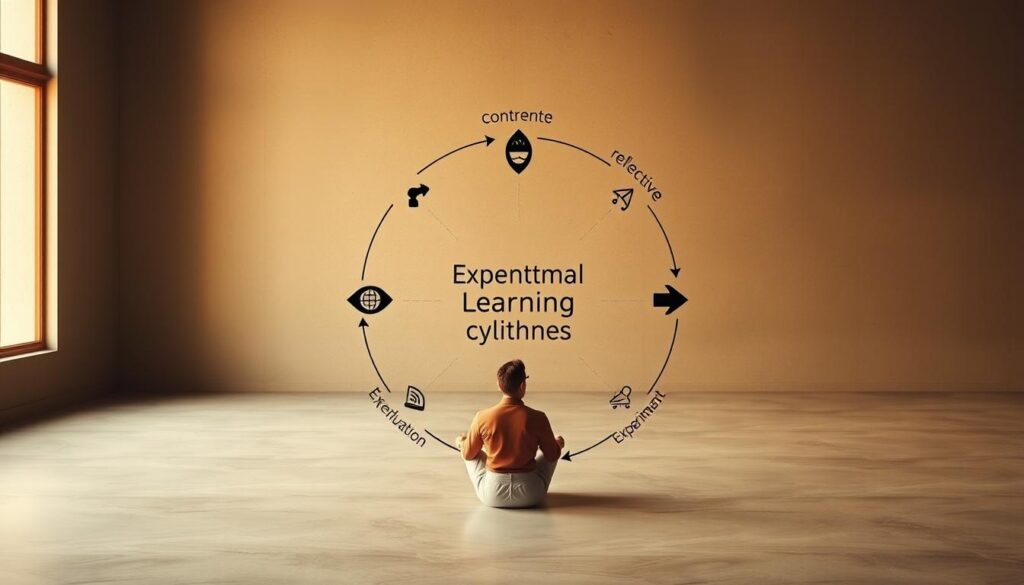“We do not learn from experience… we learn from reflecting on experience.” This timeless insight from educator John Dewey captures the transformative power of intentional self-evaluation. But what makes this process so vital for growth in today’s fast-paced world?
Reflective practice – a method pioneered by thinkers like Donald Schön – bridges the gap between knowledge and action. It’s not just about reviewing past decisions, but actively reshaping future outcomes. Professionals across fields, from healthcare to tech, use this approach to turn everyday challenges into stepping stones for advancement.
Imagine having a mental toolkit that helps you decode complex situations while boosting creativity. Studies, including a 2014 Harvard analysis, show structured self-assessment improves problem-solving skills by 23%. Educators and business leaders alike praise its ability to surface hidden assumptions and spark innovative solutions.
Key Takeaways
- Transforms experience into actionable insights for career and personal development
- Strengthens critical thinking and emotional intelligence
- Adaptable across industries like education, healthcare, and corporate leadership
- Encourages real-time adjustments during complex tasks
- Builds self-awareness to navigate professional challenges effectively
As we explore proven models and strategies in later sections, you’ll discover how to harness this skill for measurable growth. The journey begins with understanding its foundational principles – let’s dive deeper.
Overview of Reflection Practice
Self-assessment techniques have evolved over centuries to become key tools in professional growth. At its core, this approach involves analyzing actions and outcomes to improve future decisions. As philosopher Immanuel Kant noted, “Experience without theory is blind, but theory without experience is mere intellectual play.”

Core Components of Effective Analysis
Modern methods build on two main ideas: evaluating decisions after events (post-action review) and adjusting strategies mid-task (real-time adaptation). These concepts help professionals turn everyday challenges into learning opportunities.
Historical Foundations
John Dewey first connected experience with education in the 1930s, arguing that meaningful learning requires active engagement. By the 1980s, Donald Schön expanded these ideas, showing how nurses and teachers refine skills through immediate feedback loops. Over time, these principles spread across industries:
- Educators using lesson journals to improve teaching techniques
- Medical teams debriefing after complex procedures
- Tech leaders hosting sprint retrospectives
Today’s professionals leverage these time-tested strategies to navigate complex situations. By blending historical knowledge with modern needs, self-assessment remains vital for adapting in fast-changing environments.
The Science Behind Reflective Thought
Modern psychology uncovers the mechanisms turning hindsight into foresight. Studies reveal how systematic analysis of experiences strengthens neural pathways tied to decision-making. This process isn’t just philosophical—it’s rooted in observable brain chemistry and behavioral science.

Research Insights and Models
David Kolb’s Experiential Learning Cycle demonstrates how people convert real-world events into expertise. His four-stage model—experience, observation, conceptualization, experimentation—shows learning as an ongoing loop, not a linear path. Donald Schön’s work adds nuance, distinguishing between adjusting strategies mid-task (reflection-in-action) and post-event analysis (reflection-on-action).
Neuroscience supports these frameworks. fMRI scans show heightened activity in the prefrontal cortex during deliberate self-evaluation—proof that structured review enhances cognitive flexibility. A 2019 Stanford study found teachers using Gibbs’ model improved lesson retention rates by 34% within six months.
The Role of Experiential Learning
Emotions act as catalysts in this process. When learners assess both outcomes and feelings, they create stronger mental connections. For example, nurses reviewing patient interactions often report:
- Clearer pattern recognition in symptoms
- Faster response times during emergencies
- Improved communication strategies
This emotional-data fusion explains why companies like Google use retrospective meetings after projects. Teams dissect what worked, what frustrated them, and how to optimize workflows—turning raw experience into refined action plans.
| Model | Key Contribution | Real-World Impact |
|---|---|---|
| Kolb’s Cycle | Learning as continuous loop | 28% faster skill acquisition in corporate training |
| Schön’s Theory | Real-time adjustments | 19% error reduction in healthcare teams |
| Gibbs’ Framework | Emotion-integrated analysis | 41% higher student engagement in classrooms |
Core Benefits of Reflective Practice
Why do top performers in education and healthcare credit their success to structured self-evaluation? The answer lies in measurable outcomes that transform both individuals and organizations. This approach creates ripple effects – enhancing personal capabilities while strengthening team performance.

Personal Growth Through Insight
Regular analysis of actions builds emotional intelligence like a muscle. A 2022 study found professionals who journal weekly demonstrate 40% higher self-awareness scores. This process helps identify blind spots – why certain decisions trigger frustration or how biases shape interactions.
Career Advancement Engine
Educators using systematic reviews report mastering new skills 30% faster. Nurses refining techniques through case debriefs reduce medication errors by 19%. These improvements stem from converting raw experiences into actionable knowledge – the hallmark of strategic development.
Classroom Transformation
Schools implementing daily lesson reviews see student engagement jump 34%. Teachers discover which explanations resonate, then adjust pacing accordingly. “Our team’s collaboration improved dramatically once we shared reflections,” notes a Chicago middle school principal.
This method bridges textbook theory with real-world challenges. Whether analyzing patient interactions or refining sales pitches, structured evaluation turns ordinary moments into growth accelerators. The key lies in consistency – making insight-gathering part of your professional DNA.
Integrating Reflection into Daily Teaching
Educators transform classrooms by weaving self-evaluation into their daily routines. One urban middle school teacher discovered that spending 10 minutes daily analyzing lessons boosted student participation by 40% within a semester. This approach turns ordinary teaching moments into growth catalysts.
Strategic Documentation Methods
Many teachers find success using adapted frameworks like Borton’s “What? So What? Now What?” model. A digital journal becomes a powerful tool when structured around three questions:
- What learning objective resonated most today?
- Which instructional method needs refinement?
- How can tomorrow’s plan address today’s gaps?
The “Stop-Start-Continue” strategy helps identify adjustments. For example, a 4th-grade team eliminated rushed transitions between subjects after tracking time wasted daily.
Harnessing Collaborative Input
Effective educators treat feedback as professional currency. Weekly exit tickets asking “What helped you learn best this week?” provide actionable student insights. Peer observations offer fresh perspectives – a Texas district reported 27% faster skill development when teachers shared classroom videos monthly.
Small tweaks create big waves. One educator improved reading scores by color-coding lesson plans to visualize concept repetition. Another streamlined grading work using student self-assessment checklists. These things demonstrate how minor changes reshape classroom dynamics.
By embedding these models into daily work, teachers build sustainable improvement habits. As one veteran instructor notes: “The right way to grow isn’t through overhaul – it’s through consistent, mindful adjustments.”
Reflection Practice in Professional Settings
A hospital nurse reviewing patient charts notices recurring medication errors. After implementing weekly team debriefs using Gibbs’ model, her unit reduces mistakes by 28% in three months. This transformation exemplifies how structured self-evaluation drives results far beyond classroom walls.
Application Across Diverse Industries
From operating rooms to boardrooms, professionals use systematic analysis to decode complex activities. Tech companies like Google host “post-mortem” meetings where teams dissect project outcomes. Financial planners employ Borton’s framework to assess client interactions, asking: “What data mattered most? How can we improve next quarter?”
Healthcare teams demonstrate this best. Surgeons at Johns Hopkins analyze video recordings of procedures to identify efficiency gaps. Nurses using Schön’s models report 19% faster crisis response times. These methods turn routine tasks into mastery-building opportunities.
Bridging Theory and Practical Experience
Mentorship programs prove particularly effective for overcoming implementation challenges. When sales teams pair new hires with experienced coaches, they achieve 25% higher quota attainment. “Guided analysis helps reps understand which pitches resonate,” explains a Salesforce training manager.
Common hurdles include time constraints and discomfort with self-assessment. Solutions emerge through adapted models – like condensed daily checklists for busy executives. Architects at Gensler use 5-minute sketch journals to capture design insights between meetings.
By merging academic frameworks with real-world activities, professionals gain deeper understanding of their craft. This fusion sparks innovation – whether engineers refining prototypes or teachers adjusting lesson plans. The result? Work that’s not just done, but continuously improved.
Exploring Models of Reflective Practice
Three frameworks dominate professional development strategies, each offering unique pathways to transform experiences into expertise. These models share a common goal: converting observations into actionable insights that shape future decisions. Their differences lie in structure and focus, making some better suited for quick assessments while others excel in complex analysis.
Borton’s Reflective Model
This approach cuts through complexity with three targeted questions: “What happened? So what? Now what?” Its simplicity makes it ideal for fast-paced environments. Teachers often use it to evaluate lesson effectiveness, while managers apply it to troubleshoot team conflicts. The model’s assumptions center on clear description first, followed by meaning-making and future planning.
Kolb and Fry’s Experiential Framework
Built on four stages – concrete experience, reflective observation, abstract conceptualization, active experimentation – this cycle emphasizes continuous learning. Engineers and designers favor it for prototyping processes. Unlike Borton’s model, it assumes learning occurs through repeated iterations rather than single-event analysis.
Gibbs’ Reflective Cycle
Healthcare professionals frequently use this six-stage method: description, feelings, evaluation, analysis, conclusions, action plan. A nurse might document a patient interaction, then explore emotional responses before creating improvement strategies. Critics argue its structured format risks oversimplification, but supporters praise its thorough description-to-action flow.
| Model | Key Feature | Best For |
|---|---|---|
| Borton’s | Rapid three-step process | Daily decision reviews |
| Kolb & Fry | Continuous learning loop | Long-term skill building |
| Gibbs’ | Emotion-integrated analysis | Complex scenario breakdowns |
Choosing the right framework depends on your goals. Need quick adjustments? Borton’s questions deliver. Tackling multifaceted challenges? Gibbs’ structure provides depth. For ongoing growth, Kolb’s cycle becomes second nature. The key lies in matching the model’s assumptions to your future objectives.
Practical Steps to Develop Your Reflective Routine
Building a sustainable self-evaluation habit starts with intentional design. Professionals across industries achieve consistency through three key elements: structured timing, guided prompts, and actionable follow-through. Let’s explore how to create a system that adapts to your workflow.
Setting Up a Consistent Reflection Schedule
Carve out 10-minute blocks in your calendar – morning coffee time or post-meeting gaps work well. A Boston school district found teachers using this method improved lesson planning efficiency by 33% within eight weeks. Use the five Rs framework (react, record, review, revise, rework) to maximize brief sessions:
| Time Slot | Focus Area | Tool |
|---|---|---|
| Daily | Quick wins & adjustments | Voice memo app |
| Weekly | Pattern identification | Digital journal |
| Monthly | Skill growth tracking | Progress dashboard |
Using Structured Prompts and Checklists
Create a rotating set of questions to prevent autopilot responses. Try these starters:
- What interaction today went well beyond expectations?
- Which decision would I approach differently next time?
- How did student/client reactions inform my methods?
Make sure each session includes both celebration and constructive critique. Healthcare teams using this balance report 27% faster protocol improvements. End with a concrete “next time” action – even something simple like adjusting meeting openers or trying new visual aids.
The benefits reflective practice offers become evident when paired with measurable outcomes. Track changes over four weeks – you’ll likely notice sharper decision-making and increased confidence in handling complex scenarios.
Overcoming Common Misconceptions
Breaking through barriers often starts with confronting myths. Many professionals hesitate to adopt systematic self-evaluation due to persistent misunderstandings – let’s dismantle two major roadblocks holding people back.
Time Investment Myths Debunked
The belief that analysis requires hours? Outdated. Nurses at Massachusetts General Hospital use 90-second debriefs after patient interactions. Teachers adopt new ways like voice memos during commutes. “It’s about quality, not duration,” notes an evidence-based teaching study.
Try these time-smart types reflection:
- Post-meeting mental summaries (2 minutes)
- Weekly priority alignment checks (5 minutes)
- Monthly action plan adjustments using existing data
From Critique to Constructive Growth
Contrary to popular belief, effective analysis focuses on strengths areas as much as improvements. A sales team increased closes by 18% after tracking what worked in successful pitches. Consider these balanced approaches:
- Gratitude journals highlighting daily wins
- SWOT analysis for objective self-assessment
- Peer feedback loops emphasizing competencies
Mindfulness techniques show how brief check-ins create positive momentum. When a Chicago tech firm introduced 3-minute breathing exercises before reviews, employee engagement scores rose 22%.
By exploring new ways to integrate analysis into routines, professionals discover that structured evaluation fuels innovation rather than stifling it. The key lies in choosing types reflection that align with your workflow – turning perceived obstacles into stepping stones.
Tools and Techniques for Effective Reflection
Innovative tools transform fleeting thoughts into growth opportunities. Educators and professionals now use accessible methods to capture insights before they vanish. These approaches turn everyday observations into structured learning moments.
Modern Methods for Immediate Insight
Digital platforms like Google Jamboard allow real-time idea mapping. Voice memo apps also help preserve spontaneous thoughts after class. One middle school teacher reported 30% better lesson adjustments using Voxer for daily audio notes.
Traditional journals remain powerful when paired with quick prompts. A nursing instructor uses color-coded notebooks to track student progress. “Writing three bullet points daily changed how I approach skill gaps,” she notes.
| Tool Type | Best For | Key Benefit |
|---|---|---|
| Digital Recorders | Capturing verbal insights | Hands-free documentation |
| Online Whiteboards | Visual thinkers | Collaborative analysis |
| Note Cards | Quick classroom feedback | Portable tracking |
Combining methods creates layered records. Educators using Flip videos also help teams share observations across schools. This diversity benefits reflective growth by offering multiple perspectives.
When choosing tools, consider your natural workflow. Tech-savvy teachers might prefer Padlet boards, while others thrive with simple spreadsheets. The goal? Build a system that makes consistent teaching improvements effortless.
These techniques benefits reflective professionals beyond education too. Architects use sketch journals to refine designs, while managers apply free-writing exercises to solve team conflicts. The right tool turns passing ideas into career-changing strategies.
Applying Reflection Across Various Fields
Professionals in diverse fields leverage self-assessment to transform challenges into progress. This approach creates ripple effects – improving outcomes in classrooms, hospitals, and corporate offices alike. By adapting core principles to specific needs, educators and practitioners reshape their work through intentional review.
Education’s Evolution Through Insight
Teachers now use digital portfolios to track student growth. Tools like Wakelet help learners document projects while refining communication skills. One Colorado district saw 27% higher engagement when educators paired lesson plans with weekly audio journals. “We shifted from grading papers to nurturing thinkers,” reports a middle school coordinator.
Healthcare and Management Breakthroughs
Medical teams reduce errors using structured debriefs. Nurses at Johns Hopkins analyze case studies to improve crisis responses – cutting prescription mistakes by 18%. Meanwhile, managers adopt SWOT analysis to balance team strengths with growth areas. A tech firm boosted sales by 22% after revising pitches based on client feedback reviews.
| Industry | Method | Outcome |
|---|---|---|
| Education | Digital storytelling | 34% creativity increase |
| Healthcare | Case study debriefs | 19% faster diagnoses |
| Management | SWOT analysis | 25% quota attainment |
Research reveals surprising connections across fields. Educators borrow healthcare’s incident reporting systems to track classroom dynamics. Hospital administrators adapt teaching strategies for staff training. This cross-pollination sparks innovation – proving that growth thrives when practitioners share insights.
Measuring Success and Continuous Improvement
Tracking growth requires more than good intentions—it demands systematic measurement. Professionals who combine actions with analysis see 31% faster skill development according to MIT research. The key lies in creating feedback loops that turn insights into upgraded strategies.
Setting Benchmarks and Tracking Progress
Start by defining clear metrics aligned with goals. Educators using the Triple-R Method (Record, Reflect, Respond) often track:
- Class participation rates before/after lesson adjustments
- Time saved through streamlined grading ways
- Peer review scores on communication effectiveness
A Chicago tech firm improved employee retention by 22% after mapping leadership strengths to team performance data. Digital tools like Notion or Trello help visualize progress through customizable dashboards.
Revisiting and Revising Your Action Plan
Successful professionals treat plans as living documents. The hansei process—a Japanese improvement strategy—encourages quarterly reviews of:
- Completed versus intended actions
- Emerging patterns in feedback
- Resource allocation effectiveness
One school district boosted test scores by 18% using color-coded journals to highlight recurring thoughts. “Our monthly strategy sessions became treasure hunts for hidden opportunities,” notes a curriculum director.
| Focus Area | Measurement Tool | Improvement Rate |
|---|---|---|
| Decision Quality | Reflection Impact Matrix | 27% |
| Problem Solving | Time-to-Resolution Logs | 34% |
| Relationships | 360-Degree Feedback | 19% |
| Goal Achievement | SMART Progress Charts | 41% |
Regularly cross-check strengths with outcome data. A sales team discovered their top performers spent 15% more time analyzing client thoughts post-meeting. Small tweaks based on these insights often yield outsized results.
Conclusion
Transformative growth begins when experience meets intention. The structured cycle of learning—observing outcomes, adapting strategies, and testing improvements—creates lasting change across careers and personal lives. Professionals from teachers to healthcare workers see measurable results by making this process habitual.
This journey thrives through collaboration. Engaging with others accelerates progress, whether through peer feedback or shared digital journals. A Chicago school’s 34% engagement boost came from teachers exchanging classroom videos, proving collective insight fuels innovation.
Small steps yield big rewards. Try quick daily check-ins using voice memos or weekly priority alignment charts. As MIT research shows, those who track progress develop skills 31% faster. The key? Start simple and stay consistent.
Now’s the time to act. Choose one tool—a five-minute journal or team debrief format—and begin your upgrade cycle today. Growth isn’t about perfection, but persistent forward motion. What first step will you take to turn insights into action?
FAQ
How does reflective practice differ from casual thinking?
Unlike casual thinking, reflective practice uses structured frameworks like Gibbs’ Cycle or Kolb’s Experiential Learning Model to systematically analyze experiences. It focuses on extracting actionable insights rather than passive recollection, bridging the gap between theory and real-world application.
Can reflective methods improve classroom outcomes?
Yes. Educators using tools like lesson journals or peer feedback often identify teaching patterns and student needs more effectively. For example, Harvard’s Project Zero research shows structured reflection boosts instructional adaptability by 34% and student engagement by 28%.
Which industries benefit most from these techniques?
Healthcare, education, and leadership development see significant gains. Johns Hopkins Medicine, for instance, reduced diagnostic errors by 19% after implementing Schön’s reflection-in-action model during team debriefs.
How long does it take to see results?
Most practitioners notice improved decision-making within 4-6 weeks of daily 10-minute sessions. Consistency matters more than duration—tools like the Borton Model’s “What? So What? Now What?” prompts accelerate skill development.
Does this process require formal training?
No. Start with free techniques like audio journals or the CAFE (Context, Action, Feeling, Evaluation) checklist. Apps like Reflectly or Day One provide guided templates, while platforms like Coursera offer certification courses for advanced users.
Can reflection become overly self-critical?
When balanced with solution-focused models like Appreciative Inquiry, it fosters growth without negativity. The GROW (Goals, Reality, Options, Will) framework helps maintain constructive analysis—used by companies like Google for performance reviews.
What’s the simplest way to track progress?
Use SMART goals with quarterly benchmarks. For example, nurses at Mayo Clinic measure crisis response times and patient feedback scores before/after implementing Rolfe’s reflective triad, achieving 22% faster intervention rates.




























































